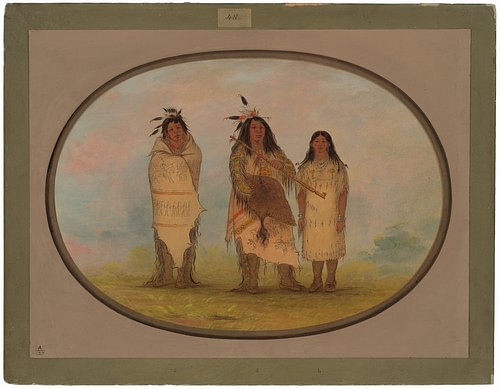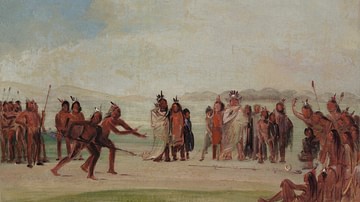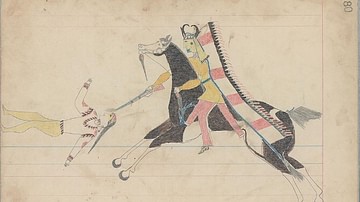The Life and Death of Sweet Medicine is a Cheyenne tale of the great prophet and law-giver Sweet Medicine who received the sacred Four Arrows, structure of government, and rules of society from Maheo, the Wise One Above, and predicted the coming of the horse, the white man, and the loss of the buffalo and the people’s land.
Among his many other gifts, the people also credit Sweet Medicine with the invention of the popular Native American game chunkey (given below as "the hoop-and-stick game"). He continues to be revered today by the Cheyenne as a foundational religious and cultural hero as well as a savior figure who brought his people from darkness into light.
Anthropologist and historian George Bird Grinnell (l. 1849-1938) notes that there are many legends concerning Sweet Medicine and many different versions of the stories (263). The tale given below shares some details with Sweet Medicine and the Arrows (given in Grinnell’s By Cheyenne Campfires) but differs in others and is a far more streamlined narrative.
The story as given here, taken from the site Pyramid Mesa, is attributed to the oral tradition of the Strange Owl family on the Lame Deer Reservation in Montana as related in 1967 and shares similarities with the version told by John Stands in Timber from the book Cheyenne Memories, Yale University Press, New Haven, CT, 1967, as reprinted in Bringing the Story of the Cheyenne People to the Children of Today, created by the Northern Cheyenne Curriculum Committee, 2006, revised 2023.
Text
A long time ago the people had no laws, no rules of behavior – they hardly knew enough to survive. And they did shameful things out of ignorance because they didn’t understand how to live.
There was one man among them who had a natural sense of what was right. He and his wife were good, hard-working people, a family to be proud of. They knew how to feel ashamed, and this feeling kept them from doing wrong.
Their only child was a daughter, beautiful and modest, who had reached the age when girls begin to think about husbands and making a family. One night a man’s voice spoke to her in a dream. "You are handsome and strong, modest and young. Therefore, Sweet Root will visit you."
Dismissing it as just a dream, the girl went cheerfully about her chores the next day. On the following night, however, she heard the voice again: "Sweet Root is coming - woman’s medicine which makes a mother’s milk flow. Sweet Root is coming as a man comes courting."
The girl puzzled over the words when she awoke, but in the end shrugged her shoulders. People can’t control their dreams, she thought, and the idea of a visit from a medicine root didn’t make any sense.
On the third night the dream recurred, and this time it was so real that a figure seemed to be standing beside the buffalo robe she slept on. He was talking to her, telling her: "Sweet Root is coming; he is very near. Soon he will be with you."
On the fourth night she heard the same voice and saw the same figure. Disturbed, she told her mother about it the next morning. "There must be something in it," she said. "It’s so real and the voice is so much like a man’s voice."
"No, it’s just a dream," her mother said. "It doesn’t mean anything."
But from that time on, the girl felt different. Something was stirring, growing within her, and after a few months, her condition became obvious: she was going to have a baby. She told her parents that no man had touched her, and they believed her. But others would not be likely to, and the girl hid her condition. When she felt the birth pangs coming on, she went out into the prairie far from the camp and built herself a brush shelter. Doing everything herself, she gave birth to a baby boy. She dried the baby, wrapped him in soft moss, and left him there in the wickiup, for in her village a baby without a father would be scorned and treated badly. Praying that someone would find him, she went sadly home to her parents.
At about the same time, an old woman was out searching the prairie for wild turnips, which she dug up with an animal’s shoulder blade. She heard crying, and following the sound, came to the wickiup. She was overjoyed to find the baby, as she had never had one of her own. All around the brush shelter grew the sweet root which makes a mother’s milk flow; so, she named the boy Sweet Medicine. She took him home to her shabby tipi even though she had nothing to offer him but love.
In the tipi next to the old woman’s lived a young mother who was nursing a small child, and she agreed to nurse Sweet Medicine also. He grew faster and learned faster than ordinary children and was weaned in no time. When he was only ten years old, he had already grown-up wisdom and hunting skill far in advance of his age. But because he had no family and lived at the edge of the camp in a poor tipi, no one paid any attention to Sweet Medicine’s exceptional powers.
That year there was a drought, very little game, and much hunger in the village. "Grandmother," he told her, "Find me an old buffalo hide - any dried out, chewed up scrap with holes in it will do."
The woman searched among the refuse piles and found a wrinkled, brittle piece that the starving dogs had been chewing on. When she brought it to Sweet Medicine, he told her, "Take this to the stream outside the camp, wash it in the flowing water, make it pliable, scrape it clean." After she had done this Sweet Medicine took a willow wand and bent it into a hoop, which he colored with sacred red earth paint. He cut the buffalo hide into one long string and wove it back and forth over the hoop, making a kind of net with an opening in the center. Then he cut four wild cherry sticks, sharpened them to a point, and hardened them in the hearth fire.
The next morning, he said: "Grandmother, come with me. We’re going to play the hoop-and-stick game." He took the hoop and the cherry-wood sticks and walked into the middle of the camp circle. "Grandmother, roll this hoop for me," he said. She rolled the hoop along the ground and Sweet Medicine hurled his pointed sticks through the center of it, hitting the right spot every time. Soon a lot of people, men and women, boys and girls, came to watch the strange new game.
Then Sweet Medicine cried: "Grandmother, let me hit it once more and make the hoop turn into a fat buffalo calf!"
Again, he threw his stick like a dart, again the stick went through the center of the hoop, and as it did so the hoop turned into a fat, yellow buffalo calf. The stick had pierced its heart, and the calf fell down dead. "Now you people will have plenty to eat," said Sweet Medicine. "Come and butcher this calf."
The people gathered and roasted chunks of tender calf meat over their fires. And no matter how many pieces of flesh they cut from the calf’s body, it was never picked clean. However much they ate, there was always more. So, the people had their fill, and that was the end of the famine. It was also the first hoop-and-stick game played among the Cheyenne. This sacred game has much power attached to it, and it is still being played.
A boy’s first kill is an important happening in his life, something he will always remember. After killing his first buffalo a boy will be honored by his father, who may hold a feast for him and give him a man’s name. There would be no such feast for Sweet Medicine, all the same, he was very happy when he killed a fat, yellow calf on his first hunt. He was skinning and butchering it when he was approached by an elderly man, a chief too old to do much hunting, but still harsh and commanding. "This is just the kind of hide I have been looking for," said the chief. "I will take it."
"You can’t have a boy’s first hide." said Sweet Medicine. "Surely you must know this. But you are welcome to half of the meat because I honor old age."
The chief took the meat but grabbed the hide too and began to walk off with it. Sweet Medicine took hold of one end, and they started a tug-of-war. The chief used his riding whip on Sweet Medicine, shouting: "How dare a poor nothing boy defy a chief?" As he whipped Sweet Medicine again and again across the face, the boy’s fighting spirit was aroused. He grabbed a big buffalo leg bone and hit the old man over the head.
Some say Sweet Medicine killed that chief, others say the old man just fell down stunned. But in the village the people were angry that a mere boy had dared to fight the old chief. Some said, "Lets whip him," others said, "Let’s kill him."
After he had returned to the old woman’s lodge, Sweet Medicine sensed what was going on. He said: "Grandmother, some young men of the warrior societies will come here to kill me for having stood up for myself." He thanked her for her kindness to him and then fled from the village. Later when the young warriors came, they were so angry to find the boy gone that they pulled down the lodge and set fire to it.
The following morning someone saw Sweet Medicine, dressed as a Fox warrior, standing on a hill overlooking the village. His enemies set out in pursuit, but he was always just out of their reach, and they finally retired exhausted. The next morning, he appeared as an Elk warrior, carrying a crooked coupstick wrapped in otter skin. Again, they tried to catch him and kill him, and again he evaded them. They resumed their futile chase on the third morning, when he wore the red face paint and feathers of a Red Shield warrior, and on the fourth, when he dressed like a Dog soldier and shook a small red rattle tied with buffalo hair at his pursuers. On the fifth day he appeared in the full regalia of a Cheyenne chief. That made the village warriors angrier than ever, but they still couldn’t catch him, and after that they saw him no more.
Wandering alone over the prairie, the boy heard a voice calling, leading him to a beautiful dark-forested land of many hills. Standing apart from the others was a single mountain shaped like a huge tipi: the sacred mountain called Bear Butte.
Sweet Medicine found a secret opening which has since been closed (or perhaps is visible to him alone) and entered the mountain. It was hollow inside like a tipi, forming a sacred lodge filled with people who looked like ordinary men and women, but were really powerful spirits.
"Grandson, come in, we have been expecting you," the holy people said, and when Sweet Medicine took his seat, they began teaching him the Cheyenne way to live so that he could return to the people and give them this knowledge.
First of all, the spirits gave him the sacred four arrows, saying, "This is the great gift we are handing you. With these wonderful arrows, the tribe will prosper. Two arrows are for war and two are for hunting. But there is much, much more to the four arrows. They have great powers. They contain rules by which men ought to live."
The spirit people taught Sweet Medicine how to pray to the arrows, how to keep them, how to renew them. They taught him the wise laws of the forty-four chiefs. They taught him how to set up rules for the warrior societies. They taught him how women should be honored. They taught him the many useful things by which people could live, survive, and prosper, things that people had not yet learned at that time. Finally, they taught him how to make a special tipi in which the sacred arrows were to be kept. Sweet Medicine listened respectfully and learned well, and finally an old spirit man burned incense of sweet grass to purify both Sweet Medicine and the sacred arrow bundle. Then the Cheyenne boy put the holy bundle on his back and began the long journey home to his people.
During his absence there had been a famine in the land. The buffalo had gone into hiding, for they were angry that the people did not know how to live and were behaving badly. When Sweet Medicine arrived at the village, he found a group of tired and listless children, their ribs sticking out, who were playing with little buffalo figures they had made out of mud. Sweet Medicine immediately changed the figures into large chunks of juicy buffalo meat and fat. "Now there’s enough for you to eat," he told the young ones, "With plenty left over for your parents and grandparents. Take the meat, fat, and tongues into the village, and tell two good young hunters to come out in the morning to meet me."
Though the children carried the message, and two young hunters went out and looked everywhere for Sweet Medicine the next day, all they saw was a big eagle circling above them. They tried again on the second and third days with no success, but on the fourth morning they found Sweet Medicine standing on top of a hill overlooking the village. He told the two: "I have come bringing a wonderful gift from the Creator which the spirits inside the great medicine mountain have sent you. Tell the people to set up a big lodge in the center of the camp circle. Cover its floor with sage and purify it with burning sweet grass. Tell everyone to go inside the tipi and stay there, no one must see me approaching."
When at last all was made ready, Sweet Medicine walked slowly toward the village and four times called out: "People of the Cheyenne, with a great power I am approaching. Be joyful. The sacred arrows I am bringing." He entered the tipi with the sacred arrow bundle and said: "You have not yet learned the right way to live. That is why the Ones above were angry and the buffalo went into hiding." The two young hunters lit the fire, and Sweet Medicine filled a deer-bone pipe with sacred tobacco. All night through, he taught the people what the spirits inside the holy mountain had taught him. These teachings established the way of the Tsistsistas, the true Cheyenne nation. Toward the morning, Sweet Medicine sang four sacred songs. After each song he smoked the pipe, and its holy breath ascended through the smoke hole up into the sky, up to the great mystery.
At daybreak, as the sun rose and the people emerged from the sacred arrow lodge, they found the prairie around them covered with buffalo. The spirits were no longer angry. The famine was over.
For many nights to come, Sweet Medicine instructed the people in the sacred laws. He lived among the Cheyenne for a long time and made them into a proud tribe respected throughout the plains.
Four lives the Creator had given him, but even Sweet Medicine was not immortal. Only the rocks and the mountains are forever. When he grew old and feeble and felt that the end of his appointed time was near, he directed the people to carry him to a place near the sacred Bear Butte. There they made a small hut for him out of cottonwood branches and cedar lodge poles covered with bark and leaves. They spread its floor with sage, flat cedar leaves, and fragrant grass. It was a good lodge to die in, and when they placed him before it, he addressed the people for the last time:
"I have seen in my mind that sometime after I am dead…and may the time be long…light-skinned bearded men will arrive with sticks spitting fire. They will conquer the land and drive you before them. They will kill the animals who give you their flesh that you may live, and they will bring strange animals for you to ride and eat. They will introduce war and evil, strange sickness and death. They will try and make you forget Maheo, the Creator, and the things I have taught you, and will impose their own alien, evil ways. They will take your land little by little, until there is nothing left for you. I do not like to tell you this, but you must know. You must be strong when that bad time comes, you men, and particularly you women, because much depends on you, because you are the perpetuators of life and if you weaken, the Cheyenne will cease to be. Now I have said all there is to say."
Then Sweet Medicine went into his hut to die.






